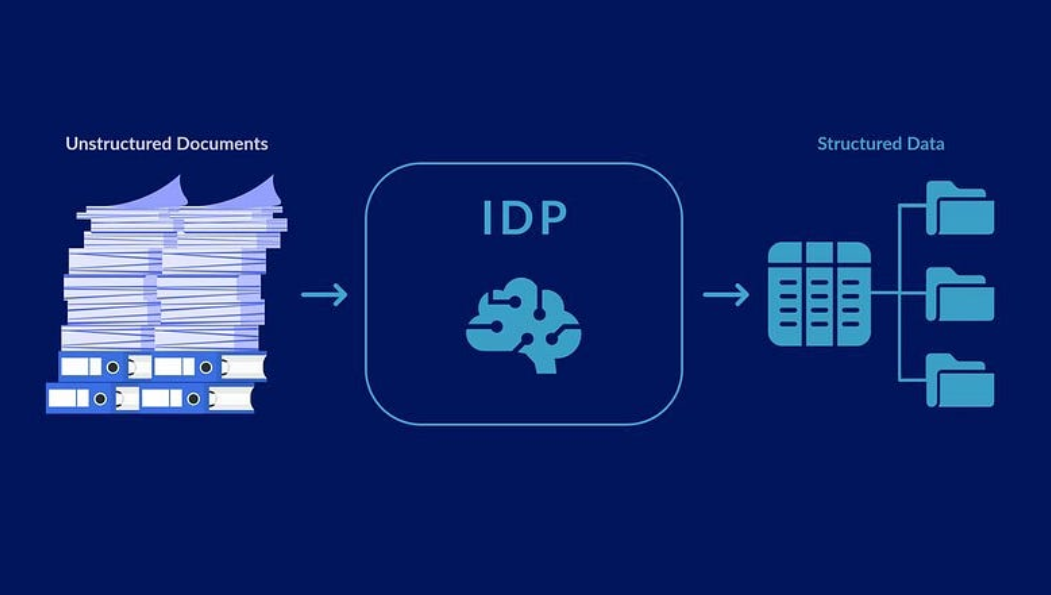
Why IDP Software Is Crucial for Data-Heavy Industries in the Digital Age
Industries like finance, healthcare, insurance, and logistics are overwhelmed by data from multiple sources. Traditional manual processing can’t keep up—leading to errors, inefficiencies, and rising costs.
Intelligent Document Processing (IDP) offers a solution. By combining AI, automation, and machine learning, IDP software turns unstructured documents into actionable data. With 63% of Fortune 250 companies already using it—and 71% adoption in finance—IDP is proving essential for scaling operations and improving accuracy.
It enables faster decision-making, reduces dependency on manual tasks, and improves compliance. As document volumes grow, IDP ensures businesses stay agile and competitive in a digital-first world.
What is IDP Software?
Intelligent Document Processing (IDP) refers to the use of artificial intelligence (AI), machine learning (ML), natural language processing (NLP), and optical character recognition (OCR) to automate the extraction, classification, and processing of data from documents. Unlike traditional data capture methods, IDP can handle both structured and unstructured data, making it versatile and applicable across various industries.
The Importance of IDP in Data-Heavy Industries
Managing massive unstructured data in industries such as finance, healthcare, and legal is crucial to staying competitive. Here’s why Intelligent Document Processing (IDP) software is essential in these data-heavy industries:
- Improved Efficiency and Speed
IDP software automates repetitive tasks, significantly reducing the time required for data entry and processing. For instance, in the financial sector, IDP can automate invoice processing, reducing the time spent per invoice from hours to mere minutes. This acceleration leads to faster decision-making and improved cash flow management.
- Higher Accuracy and Reduced Errors
Manual data entry is prone to human errors, which can lead to costly mistakes. IDP software minimizes these errors by automating data extraction and validation processes. For example, in healthcare, IDP can extract patient information from medical records with high accuracy, reducing the risk of misdiagnosis due to incorrect data.
- Cost Savings
By automating document processing, organizations can reduce the need for manual labor, leading to significant cost savings. In insurance, for example, IDP can automate claims processing, reducing administrative costs and allowing employees to focus on more complex tasks.
- Scalability
As businesses grow, so does the volume of data they handle. IDP software can scale to accommodate increasing data volumes without a proportional increase in resources. This scalability is particularly beneficial for industries like logistics, where the volume of shipping documents can fluctuate based on demand.
- Compliance and Security
IDP software helps organizations maintain compliance with industry regulations by ensuring that data is processed and stored securely. In the legal industry, for instance, IDP can automate the extraction of contract terms, ensuring that all necessary clauses are included and compliant with regulations.
Read also: IPTV Technology: Understanding How IPTV Works and Its Benefits
Key Features of IDP Software
Intelligent Document Processing (IDP) software incorporates a range of powerful features that enable organizations to automate and optimize their document-centric workflows. By leveraging advanced technologies such as Optical Character Recognition (OCR), Natural Language Processing (NLP), and Machine Learning (ML), IDP systems transform the way businesses manage, process, and extract value from their documents. Let’s dive into the key features that make IDP software an invaluable asset for data-heavy industries:
1. Document Classification
IDP software automatically categorizes incoming documents based on their content. Whether it’s invoices, contracts, medical records, or customer correspondence, the system can recognize and classify documents correctly. This feature significantly reduces manual sorting, ensuring that the right document type is routed to the correct processing path. For instance, invoices might be routed to an accounts payable system, while contracts are directed to the legal team for further review. Automating document classification speeds up workflows and reduces the chance of errors associated with manual classification.
2. Data Extraction
One of the core functions of IDP software is its ability to extract critical data from various document formats. Using OCR, NLP, and ML, the system identifies and extracts relevant information such as invoice numbers, customer details, dates, and amounts. For example, an invoice can be scanned and the IDP system will automatically pull out the vendor name, amount due, and payment terms. This automation drastically cuts down the time spent on manual data entry, speeds up the processing time, and reduces human error, ensuring that only the most accurate data is captured.
3. Data Validation
Ensuring the accuracy of extracted data is critical to avoid costly mistakes. IDP software cross-references the extracted information with existing databases or predefined rules to validate its correctness. For instance, if a purchase order number or an account number is extracted from an invoice, the system will automatically check it against the ERP system or accounting records to confirm that the data matches. This real-time validation ensures that only accurate and consistent information moves forward in the workflow, reducing errors and minimizing the risk of financial discrepancies.
4. Workflow Automation
IDP software doesn’t just stop at data extraction; it goes further by automating the entire document workflow. Once the document is classified and the data is extracted, it is routed through predefined approval processes. This means invoices, contracts, or other documents are automatically sent to the correct individuals or teams for review, approval, or further processing. For example, an invoice might automatically be sent to the finance team for approval and payment scheduling. Workflow automation enhances operational efficiency by reducing bottlenecks, minimizing delays, and ensuring that critical tasks are completed on time.
5. Integration Capabilities
A seamless integration with existing enterprise systems is essential for maximizing the value of IDP software. The best IDP solutions integrate effortlessly with systems like Enterprise Resource Planning (ERP), Customer Relationship Management (CRM), and document management platforms. This ensures that data flows smoothly between systems without the need for duplicate entries or manual intervention. Whether it’s feeding invoice data into an accounts payable system or pushing customer data into a CRM, integration capabilities allow businesses to create a fully automated, interconnected workflow that is both efficient and scalable.
Incorporating these features into an organization’s document management system allows for faster, more accurate processing of information, reducing the reliance on manual labor and significantly improving efficiency across departments.
Challenges and Considerations When Implementing IDP Solutions
While Intelligent Document Processing (IDP) offers immense value, successful implementation requires careful planning. Here are key challenges organizations should consider:
- Data Quality
The accuracy of IDP depends heavily on input data quality. Poorly scanned or low-resolution documents can lead to extraction errors and require manual corrections. Pre-processing steps like image enhancement or document cleanup are essential to ensure reliable results.
- System Integration
Integrating IDP with existing ERP, CRM, or legacy systems can be complex. Compatibility issues and the need for APIs or custom connectors may increase setup time and cost. A clear understanding of current IT infrastructure is crucial for seamless integration.
- Implementation Cost
While IDP saves money long-term, upfront costs for software, integration, and training can be high. A detailed ROI analysis can help justify these expenses by weighing them against labor savings, reduced errors, and faster processing.
- Change Management
Adopting IDP often requires a mindset shift. Resistance to change can hinder implementation, so it’s important to provide training, support, and clear communication about the benefits. Engaging stakeholders early helps drive smoother adoption.
- Vendor Selection
Not all IDP platforms are created equal. Choose a solution that fits your industry, supports custom workflows, and offers strong vendor support. Pre-trained models and scalability are additional advantages that improve efficiency and outcomes.
By proactively addressing these factors, organizations can ensure a smoother deployment, minimize disruptions, and maximize the benefits of IDP technology.
Conclusion
Intelligent Document Processing (IDP) software is transforming how data-heavy industries like finance, healthcare, insurance, and logistics manage information. By automating data extraction, improving accuracy, and enhancing compliance, IDP enables scalable operations without adding resources. However, successful adoption depends on factors like data quality, integration, cost, and vendor choice.
Docsumo offers a powerful AI-driven IDP solution tailored for industry-specific needs. With features like high-accuracy extraction, seamless integration, and customizable models, it simplifies document workflows at scale.
Start your free 14-day trial today and book a demo to see how Docsumo can streamline your data processing.




